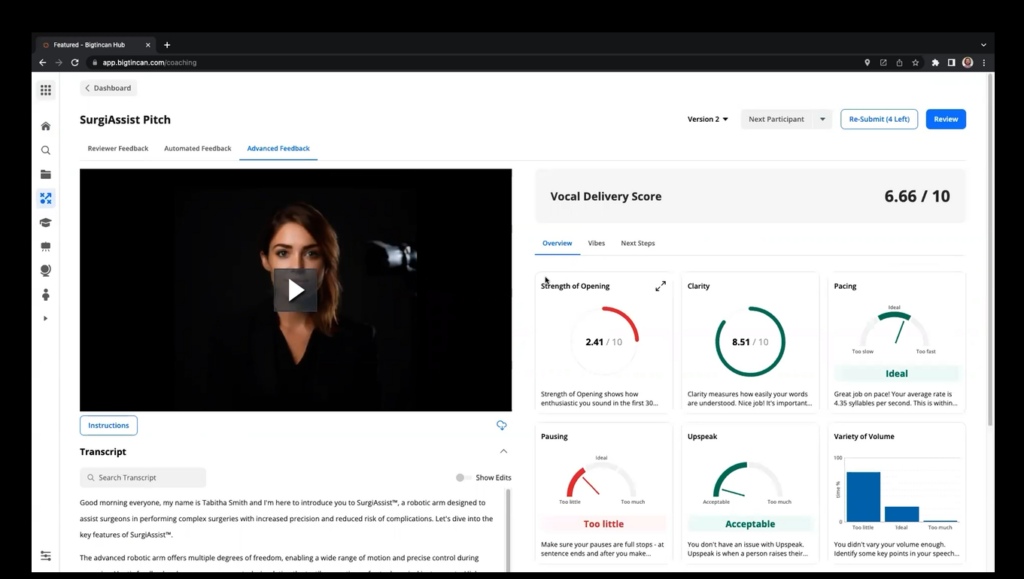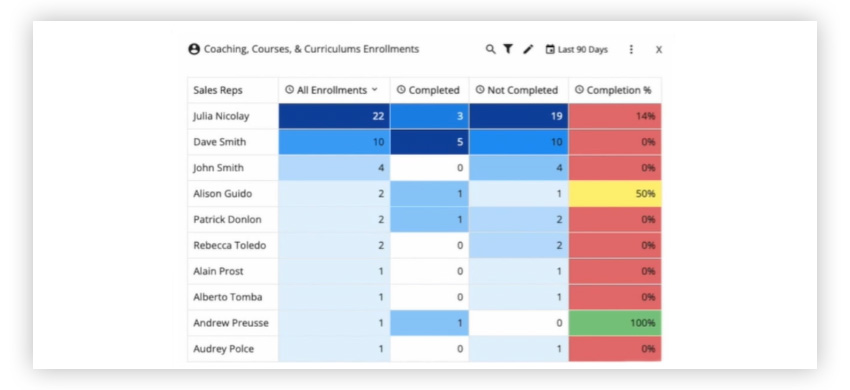How to create a coaching culture in your organization

If you’re trying to maximize sales rep performance and drive results, coaching should be an essential part of your strategy.
CSO Insights reported that sales coaching has had the greatest impact on win rates and quota attainment over the span of five years. In addition, the International Coaching Federation said:
- 80% of those who receive coaching report more confidence
- 70% benefited from improved work performance (including better relationships and more effective communication skills)
- 86% reported a recouped investment in coaching
Both CSO Insights and the International Coaching Federation have proposed a compelling argument. So, let’s say we all agree with them, and you’ve done the work to achieve executive buy-in. You’re now ready to start implementing the plan. Here’s how you can turn your managers into great coaches and develop a coaching culture at your organization.
What is a coach’s role, and what can we do to help give them the tools they need to succeed?
Our instinct is to simply put sales reps and managers into coaching positions and hope for the best. We often do so without providing the necessary tools and information for them to be successful.
Let’s look at the example of a conductor in an orchestra. The conductor shares the common goals of the team. They:
- Work through rehearsals, the performance, and provide an evaluation, much like a sales coach.
- Try to get the best out of each individual and the collective performance of the orchestra.
- Provide encouragement, direction, and redirection throughout a performance.
- Might not always be the strongest player on the team. But some would argue they’re the most important.
- Not only keep the orchestra on track, but act as the team’s leader and “guide.”
The best sales “conductors” are going to have an open-door policy to engage sales reps in a discussion and feedback, manage pre-show rehearsals and evaluation. They’re going to then look at all of those factors to try to continuously improve the performance.
We must ask our coaches to provide feedback in a way that builds confidence in the capabilities of the team but also turns a manager into a great conductor – or in this case, a great coach.
Let’s not think that coaching is a natural skill for our managers. Instead, we need to provide the tools to help them develop the necessary skills.
4 ways to develop sales coaches
- Enable managers with coaching tools
- Use the tools to analyze how well managers are coaching
- Identify gaps and train managers on coaching skills
- Assess the team performance to evaluate coaching effectiveness
Enable managers with coaching tools
Managers need the tools to succeed, but with such a broad spectrum available, you must choose wisely. I like to break down the tools into different categories.
First, invest in a platform for providing ongoing dialogue with coaches, managers, and reps. Next, implement tools to help during practice. Then, explore tools used to evaluate the actual performance. And finally, discover tools that provide a more holistic view of the data you’ve gathered throughout the process.
Ongoing dialogue
The first one is really simple. You can start it today by using a threaded coaching discussion. At Brainshark, we use Slack. Its primary purpose is to provide a platform for daily tips, techniques, and stories from other reps. It provides a platform for feedback from coaches and managers. You’d be surprised as to the depth of dialogue that naturally occurs during this, including feedback that’s not only constructive but also encouraging.
This example shows how a sales manager posted a win story from a top rep. Almost immediately, other reps started to chime in with constructive feedback, or “I didn’t know that,” and “have you tried this.” It’s a subtle way to begin forming a coaching culture, and all you have to do is enable that channel.
An area you shouldn’t overlook is the power and value of peers as coaches. Peers can become coaches if you enable the environment for them to do so. By providing opportunities for peers to help each other practice and hone their skills, you take the pressure off the coach and the sales enablement team.
Further reading: Peer learning: Why it’s so important for remote sales teams and how enablement leaders can foster it
The benefits of leaderboards
Leaderboards have several benefits. They provide a lens into what good is since you can ensure only the top performances are on the board. Second, they can provide a platform for peer feedback. I could click on one of those videos, watch it and then give one-on-one feedback to the presenter. Last but not least they can instill a little bit of friendly competition.

Enabling practice
Next, let’s look at what we can do to enable practice and enabling feedback during practice. It’s nearly impossible with a remote workforce to do the ride-alongs we used to do. Using a coaching platform helps coaches and managers visualize whether or not the sales rep is ready before the call. You don’t want the first time a rep handles an objection to be when they are on a call with a prospect.
Practice makes perfect
We’ve all heard this our whole lives “practice make perfect”. As cliché as it may be, it’s true. You must practice your presentation. This used to be done in front of a mirror, but at Brainshark we’ve developed a better mirror to encourage feedback. With the Brainshark platform, you can set up a challenge or a coaching activity for a specific purpose. Maybe it’s how to deliver the elevator pitch or to handle a tough objection. Coaches and managers can quickly watch a presentation. They can even do it at double speed to save time. They can rate specific parts of the presentation to provide feedback, all in this safe environment. While reps are practicing and sharing their thoughts. If feedback is provided in the right way, it will encourage reps to practice and try again.

Instilling the habits to practice helps create your coaching culture and improve rep performance in a live situation.
As important as it is, video coaching does take some resources from your sales reps and from your managers. It can also take time for a coach or reviewer to provide feedback and take time away from selling.
After hearing this feedback from our customers, we’ve developed a virtual coach that uses advanced feedback via machine analysis. Brainshark’s machine analysis provides instant, advanced feedback and really encourages sales reps to “try again.” It also automatically evaluates the reps adherence to the message. You can specify the words and phrases you want your rep to say when delivering the message. As well as words you’d rather not hear. You can do all this when setting up a coaching activity. We also assess their percentage of filler words: ums, ahs, likes, and you knows. We know that research tells us that after about 1.28% of filler words, the perception of confidence and preparedness starts to rapidly decline.
The machine analysis compiles all of the data and provides a machine score to allow managers and reps to quickly identify the reps who need the most coaching. Let’s say you have hundreds of sales reps or thousands of sales reps. You can quickly look at who’s at the top who’s at the bottom. You can then either coach to the middle or coach to the reps who may need the most help.
Further reading: How AI-powered sales coaching improves your pitch
Use the tools to analyze how well managers are coaching
You now have the tools to use during the practice and learning stages. The next thing you want to consider is adding a layer that will allow you to observe how well reps are actually performing. The difference here is now the pressure is on. You can observe a sales rep under natural and real sales circumstances.
Brainshark integrates with conversation intelligence tools that can help you get a complete view of your customer interactions with real-time data on the reality of actual sales calls. You will quickly see what reps are saying, what the common themes are, and also track coaching data and how it correlates with sales performance – all so you can quickly look at which coaches are actually listening to calls and who’s providing feedback. All that data, including the actual call itself, can be brought into a Brainshark Scorecard:

Analyzing the data
Next, let’s talk about analyzing all of the data gathered from all of those tools and solutions. Sales enablement teams can learn a lot from the data as all of these activities are taking shape. Are coaches giving good feedback during practice? Are they reviewing calls and providing feedback on the playback of the actual calls?
Here’s one example of how a Brainshark Scorecard can help you answer those questions and quickly identify managers who are coaching well.
Scorecards also allow you to quickly identify those coaches that might need some coaching. Those who might be giving everyone all scores of a hundred. Or they might provide a really low feedback word count. Meaning they probably said “good job” or “nice work.” Not really all that constructive.
You can also look to see which coaches are taking way too long to provide any feedback at all. Brainshark gives you this data in addition to metrics from Gong to show how many calls a coach listened to and gave feedback on. This will allow you to make decisions on where you might want to focus to coach your coaches.
Identify gaps and train managers on coaching skills
How do you find good coaches?
You can certainly look for coaches outside your organization. Still, it’s more likely you’re going to want to leverage existing managers and reps. By leverage your existing team as coaches, you can cultivate your coaching culture from within.
Sounds great, but how do you do that? First, it’s essential to look at the traits of a manager versus a coach. Knowing the differences allows you to develop training to move managers on the coaching spectrum.
Managers:
|
Coaches:
|
Our coaches are now on track. We’ve established an open-door communication plan and are using video coaching and machine analysis. We know our reps are ready, based on the data we’re getting back. We know our coaches are providing valuable feedback in a timely way. And we’ve also given the tools to visualize the actual sales conversation. However, we still don’t know if any of this is actually working.
Assess the sales team performance to evaluate coaching effectiveness
To assess effectiveness, we need to pull in data from your CRM directly to quickly identify training opportunities. With Brainshark Scorecards you can quickly see how your reps are doing.
For example, your top rep might be leading the team on opportunities created and pipeline created – so they’re doing the work. But their ability to close and their level of bookings are areas of concern. We may not know the exact cause, but at least we’ve identified what needs a closer look.
Drilling into the rep’s performance over time shows they’re doing the work. They’ve taken a lot of courses. They’ve done coaching activities but compared to their team, they have below average coaching scores. They have not passed a couple courses that they were asked to take. This suggests that they need coaching in those key areas, which could clearly directly impact the issues. We saw where they were having trouble with closing and overall bookings.
Having access to this data helps you find the top and lowest reps and enables you to find the middle. There’s a real common sales strategy that focuses on coaching to the middle. This data will help you do that.
Key takeaways
For coaching to be truly successful at your company, you have to enforce the initiative early on to train sales managers into coaches.
Sales managers don’t inherently know how to coach, and they shouldn’t really be expected to know how. They were hired as a manager, things evolve, and they are then asked to coach. A lot of times, they also don’t know they’re not coaching. For instance, they might think, “oh I thought that was coaching.” They don’t know what they don’t know. We ask a lot of our sales managers, often asking them to go from great sales rep to great sales manager and coach.
The other thing to keep in mind is they may not admit that they don’t know some things.
Coaching is an essential component to a sales strategy, but we know coaches need guidance and tools. Being data-driven can help us identify what’s working, what isn’t and provide opportunities for additional coaching for both coaches and reps.
Interested in learning more about how you can create a coaching culture and turn managers into effective coaches? Have a chat with our team.

